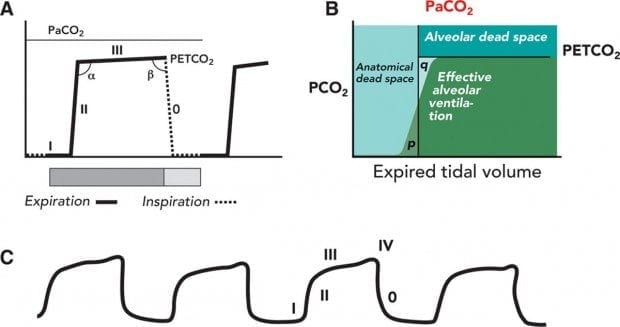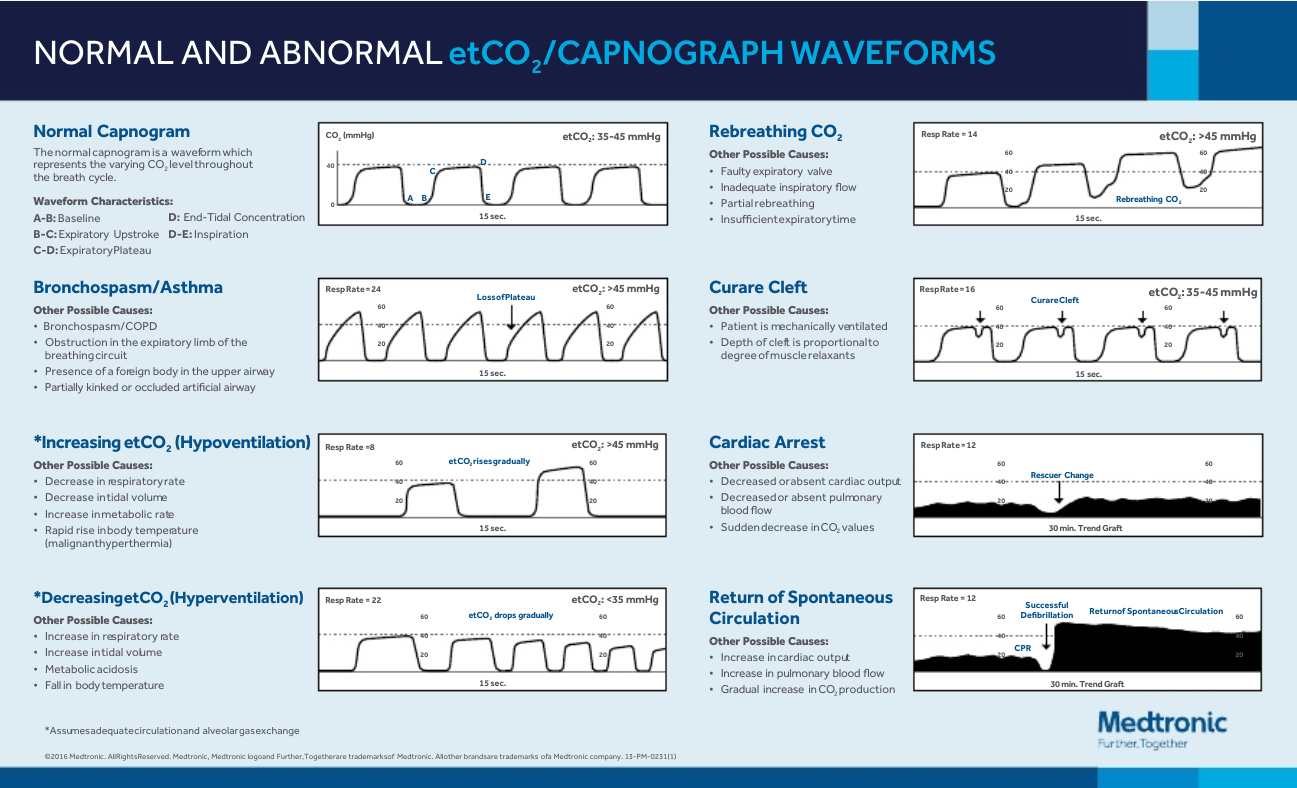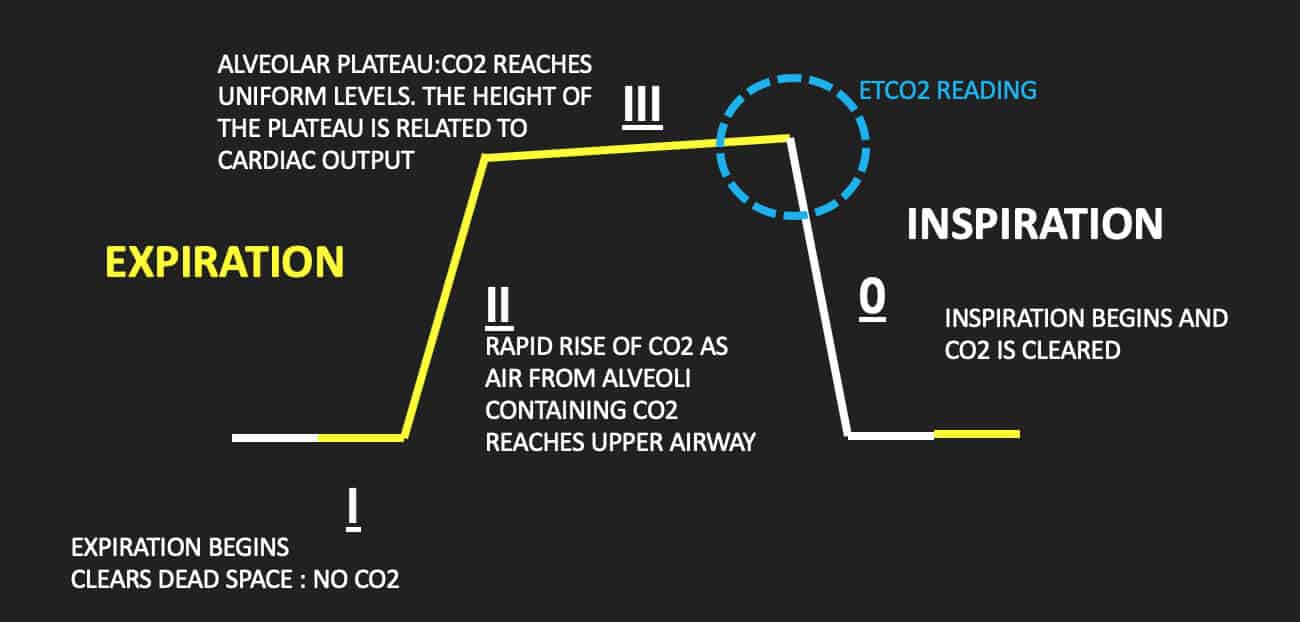end tidal co2 meaning
Infinium Medicals end tidal CO2 EtCO2 monitor the Infinium EnTide is an affordable reliable and accurate piece of medical equipment designed to help health care professionals across the globe provide their patients with the best care possible. MONITORING of end-tidal carbon dioxide is one of the most important means of determining the physiologic well-being of anesthetized patients.

Quantitative Waveform Capnography Acls Medical Training
Most medical sources define hypocapnia as less than 35 mm Hg for partial CO2 pressure in the arterial blood.

. In the ED we typically think of a EtCO2 as a marker of perfusion and ventilation. This is a major respiratory symptom. On average during CPR if adequate chest compressions are being delivered a cardiac index of 16-19 Lminm2 can be generated which correlates with ETCO2 pressures of 20mmHg.
Since 2001 Infinium Medical has been designing and manufacturing a wide range of leading-edge medical. In the awake adult normal cardiac index lies between 25-4 Lminm2 with an ETCO2 of 35-45 mmHg. We routinely use ETCO2 to provide information on ventilation.
Eisenberg and Terry J. However ETCO2 may be underused in the PED setting. The arterial CO2 value for normal breathing at rest is 40.
CO2 is a byproduct of cellular metabolism which gets transported in the blood to the lungs for elimination. Carbon dioxide CO 2 is a product of metabolism transported via perfusion and expelled through ventilation. It is the standard of care during certain procedures such as intubations and sedations and can be used in variety of clinical situations.
End tidal co2 meaning Sunday February 27 2022 Edit The high temperature and pressure in Earths interior cause some rock to melt and solid mantle to behave plastically. 1 ACLS guidelines define high quality chest compressions as. End-tidal CO 2 etCO2 monitoring via capnography for example has been a valuable tool in clinical settings emergency medicine for many decades see medical reviews.
Definition of Low CO2 hypocapnia Hypocapnia hypocapnea also known as hypocarbia is defined as a deficiency of carbon dioxide in the arterial blood. Low EtCO 2 with other signs of shock indicates poor systemic perfusion which can be caused by hypovolemia sepsis or dysrhythmias. Medical Definition of end-tidal.
The gradient is the difference between the arterial carbon dioxide partial pressure PaCO 2 and the etCO 2 partial pressure is a result of the relationship between ventilation and perfusion or rather ventilation-perfusion matching VQ. End-tidal capnography or end-tidal CO2 EtCO2 monitoring is a non-invasive technique that measures the partial pressure or maximal concentration of carbon dioxide CO2 at the end of an exhaled breath. When calculating the gradient the clinician is comparing the carbon dioxide CO 2 sampled from the ABG.
Exhaled carbon dioxide both in terms of its quantity and pattern provides detailed information on the cardiopulmonary system. End-tidal CO2 ETCO2 monitoring is not a new modality in the pediatric emergency department PED and emergency department. EtCO 2 reflects cardiac output and pulmonary blood flow as CO 2 is transported by the venous system to the right side of the heart and then pumped to the lungs by the right ventricle as well as the ventilation minute volume Paiva et al 2018.
The amount of CO2 at the end of exhalation or end-tidal CO2 ETCO2 is normally 35-45. End-tidal CO 2 monitoring has also been useful for breathing retraining as it provides additional information. Cambra.
But ETCO2 can also provide valuable information on the adequacy of cardiac perfusion. Define End tidal carbon dioxide ETCO2 capnography. However EtCO2 is an extremely powerful surrogate for endotracheal tube ETT P osition CPR Q uality R eturn of spontaneous circulation ROSC S trategies for treatment and T.
End tidal carbon dioxide concentration. In critical care End Tidal CO 2 monitoring is used to assess adequacy of circulation to the lungs which provides clues about circulation to the rest of the body. Like pulse oximetry before it alerting us to changes in oxygenation end-tidal CO2 monitoring or ETCO2 is rapidly becoming an additional vital sign.
End-tidal CO2 EtCO2 monitoring is a measure of metabolism perfusion and ventilation. The normal values are 5-6 CO2 which is equivalent to 35-45 mmHg. End-tidal carbon dioxide is the partial pressure of carbon dioxide EtCO 2 at the end of an exhaled breath.
Of or relating to the last portion of expired tidal air End-tidal carbon dioxide monitors are already being used and are recommended to indicate the adequacy of cardiopulmonary resuscitation and the likelihood of a successful resuscitation. Means monitoring of the concentration or partial pressure of end tidal carbon dioxide in respiratory gases. Mengert The New England Journal of Medicine.
End-tidal carbon dioxide EtCO 2 waveform monitoring allows you to measure all three. Bhende MS LaCovey 2001.

Basic Capnography Interpretation Nuem Blog

E Learning Basics Of Capnography Youtube

Waveform Capnography In The Intubated Patient Emcrit Project
Riding The Wave Of Capnography Understanding Etco2 Vetbloom Blog

Basic Capnography Interpretation Nuem Blog

How To Read And Interpret End Tidal Capnography Waveforms Emsuk Learning
End Tidal Co2 Monitoring In The Pre Hospital Environment More Than Just Endotracheal Tube Placement Confirmation Journal Of Paramedic Practice

Etco2 Valuable Vital Sign To Assess Perfusion The Airway Jedi

Waveform Capnography In The Intubated Patient Emcrit Project

Basic Waveform Capnography As A Continuous Monitoring Tool During Mechanical Ventilation

Capnography Waveform Interpretation Litfl Ccc Equipment

Normal And Abnormal Capnography Waveforms Infographic Capnoacademy Capnoacademy
The Normal Capnograph Waveform Deranged Physiology
End Tidal Co2 The Drummer Of The Vital Sign Band Pem4
Emdocs Net Emergency Medicine Educationcapnography In The Ed Emdocs Net Emergency Medicine Education

Waveform Capnography In The Intubated Patient Emcrit Project

Capnography Provides Bigger Physiological Picture To Maximize Patient Care Jems Ems Emergency Medical Services Training Paramedic Emt News

